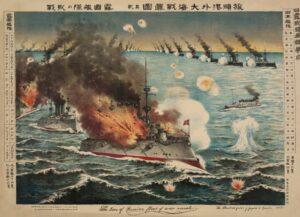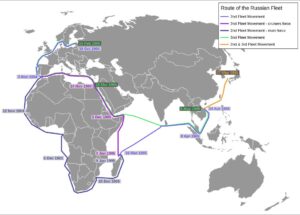port arthur
 It’s a difficult thing to discover that, as a nation, with a naval fleet, what you thought was strong, is simply not enough. This was the position that Russia found themselves during the Russo-Japanese War, when the Russian Baltic Fleet is nearly destroyed at the Battle of Tsushima Strait. The defeat was devastatingly decisive. Only 10 of the 45 Russian warships were able to escape to safety. The Russian leaders had to face the fact that further resistance against Japan’s imperial designs for East Asia was hopeless. They could not do it alone.
It’s a difficult thing to discover that, as a nation, with a naval fleet, what you thought was strong, is simply not enough. This was the position that Russia found themselves during the Russo-Japanese War, when the Russian Baltic Fleet is nearly destroyed at the Battle of Tsushima Strait. The defeat was devastatingly decisive. Only 10 of the 45 Russian warships were able to escape to safety. The Russian leaders had to face the fact that further resistance against Japan’s imperial designs for East Asia was hopeless. They could not do it alone.
The Japanese wanted to divide Manchuria and Korea into spheres of influence, but the plan was rejected by the Russians on February 8, 1904, following the Russian rejection of a Japanese plan to Japan launched a surprise naval attack against Port Arthur, a Russian naval base in China. With that attack, the war was on. The Battle of Port Arthur on February 8 and 9, 1904 marked the commencement of the Russo-Japanese War. The Japanese, in true Japanese style attacked when all the ships were still in port, but I guess that is how war is. It reminds me of Pearl Harbor, of course. The attack was a surprise night attack by a squadron of Japanese destroyers on the neutral Russian fleet anchored at Port Arthur, Manchuria. They continued with another attack the following morning. The fighting would continue until  May 1904. While the attack on Port Arthur ended inconclusively, the war was without a doubt, a Japanese victory. The Battle of Port Arthur was the first major battle of the 20th century, and the Russian fleet was decimated. During the war that began then, Japan won a series of decisive victories over the Russians, who underestimated the military potential of its non-Western opponent. In January 1905, the continued attacks resulted in the fall of Port Arthur to Japanese naval and ground forces under Admiral Heihachiro Togo, and by March Russian troops were defeated at Shenyang, China, by Japanese Field Marshal Iwao Oyama. Then came the Battle of Tsushima Strait, fought on May 27 and 28, 1905 (May 14 and 15 in the Julian calendar that Russia used at that time) in the Tsushima Strait located between Korea and southern Japan.
May 1904. While the attack on Port Arthur ended inconclusively, the war was without a doubt, a Japanese victory. The Battle of Port Arthur was the first major battle of the 20th century, and the Russian fleet was decimated. During the war that began then, Japan won a series of decisive victories over the Russians, who underestimated the military potential of its non-Western opponent. In January 1905, the continued attacks resulted in the fall of Port Arthur to Japanese naval and ground forces under Admiral Heihachiro Togo, and by March Russian troops were defeated at Shenyang, China, by Japanese Field Marshal Iwao Oyama. Then came the Battle of Tsushima Strait, fought on May 27 and 28, 1905 (May 14 and 15 in the Julian calendar that Russia used at that time) in the Tsushima Strait located between Korea and southern Japan.
While hope seemed lost, Russian Czar Nicholas II still hoped that the Russian Baltic fleet under Admiral Zinovy Rozhestvensky would be able to challenge Admiral Togo’s supremacy at sea. Unfortunately, during the two-day Battle of Tsushima Strait, more than 30 Russian ships were sunk or captured by the superior Japanese warships. Japanese superiority was made abundantly clear. By August, with a stunning string of Japanese victories, Russia became convinced that they would have to accept the peace treaty mediated by US President  Theodore Roosevelt at Portsmouth, New Hampshire…a treaty that won Roosevelt the Nobel Peace Prize for this achievement. In the Treaty of Portsmouth, Russia recognized Japan as the dominant power in Korea and gave up Port Arthur, the southern half of Sakhalin Island, and the Liaotung Peninsula to Japan.
Theodore Roosevelt at Portsmouth, New Hampshire…a treaty that won Roosevelt the Nobel Peace Prize for this achievement. In the Treaty of Portsmouth, Russia recognized Japan as the dominant power in Korea and gave up Port Arthur, the southern half of Sakhalin Island, and the Liaotung Peninsula to Japan.
Japan emerged from the conflict as the first modern non-Western world power and set its sights on greater imperial expansion. Japan would have to be dealt with another day, and by another power. As for Russia, the military’s disastrous performance in the war sparked the Russian Revolution of 1905.
 In the Fall of 1957 or 1958, my family was living in Superior, Wisconsin, which is where my dad’s family lived. I was just a toddler at the time, and our family had been visiting Casper, Wyoming, where Mom’s family lived. My grandma and my Aunt Sandy were to accompany us back to Wisconsin for a visit, and then they would take the bus home again. The amount of room in the car limited the number of people who could come to two, and my Aunt Sandy felt very blessed to be chosen, as a trip to Canada was in the plans. It was to be the only time Aunt Sandy traveled outside the United States…so far, anyway.
In the Fall of 1957 or 1958, my family was living in Superior, Wisconsin, which is where my dad’s family lived. I was just a toddler at the time, and our family had been visiting Casper, Wyoming, where Mom’s family lived. My grandma and my Aunt Sandy were to accompany us back to Wisconsin for a visit, and then they would take the bus home again. The amount of room in the car limited the number of people who could come to two, and my Aunt Sandy felt very blessed to be chosen, as a trip to Canada was in the plans. It was to be the only time Aunt Sandy traveled outside the United States…so far, anyway.
Aunt Sandy tells me that one of the most wonderful memories she has of the trip is the fall colors in the trees. Wyoming gets pretty much one color change in the fall…green to yellow. The reds you see in the Midwest and East are pretty foreign in Wyoming. The drive was very exciting for a young girl of 12 or 13 years.
The Canadian part of the trip would also be filled with lovely fall colors, and would take them to Port Arthur to stay the night. They drove along the north shore of Lake Superior, which is a beautiful drive, as I can attest. It was always a favorite of my parents, and of course, most people who live around Lake Superior. The area is filled with trees, and magnificent views of the lake, so it is always a very special treat.
At some point in touring of the area, we stopped to look around, and Aunt Sandy leaned up against a fence post. Not knowing the problems that can occur when you put a wooden post in the ground for a long period of time in a climate that is humid, and ground water is plentiful, poor Aunt Sandy had no idea that leaning against such a post was a bad idea. The post immediately broke, of course, and Aunt Sandy found herself laying in the sand. Big sisters being with they are with their kid sisters, my mother began laughing hysterically about her little sister “throwing herself in the sand”. Thankfully Aunt Sandy wasn’t bothered by her sister’s teasing, or maybe it was just that she was used to teasing, being the youngest of 9 children. Nevertheless, Mom laughed, and Aunt Sandy picked herself up,  and blew off the laughter good naturedly. I guess the trip was too much fun to worry about such trivial things.
and blew off the laughter good naturedly. I guess the trip was too much fun to worry about such trivial things.
All too soon, the trip came to an end. But there was still one adventure to come. Grandma and Aunt Sandy were going to be going home on the bus. Now, as we all know, bus trips are very long, with stops in just about every Podunk town on the map, but to a young girl of 12 or 13 years, it was still a very exciting trip, and one that she has never forgotten in all these years. I could tell, as I was talking to her about her memories of the trip, that they are still very much alive and well in her memory.

